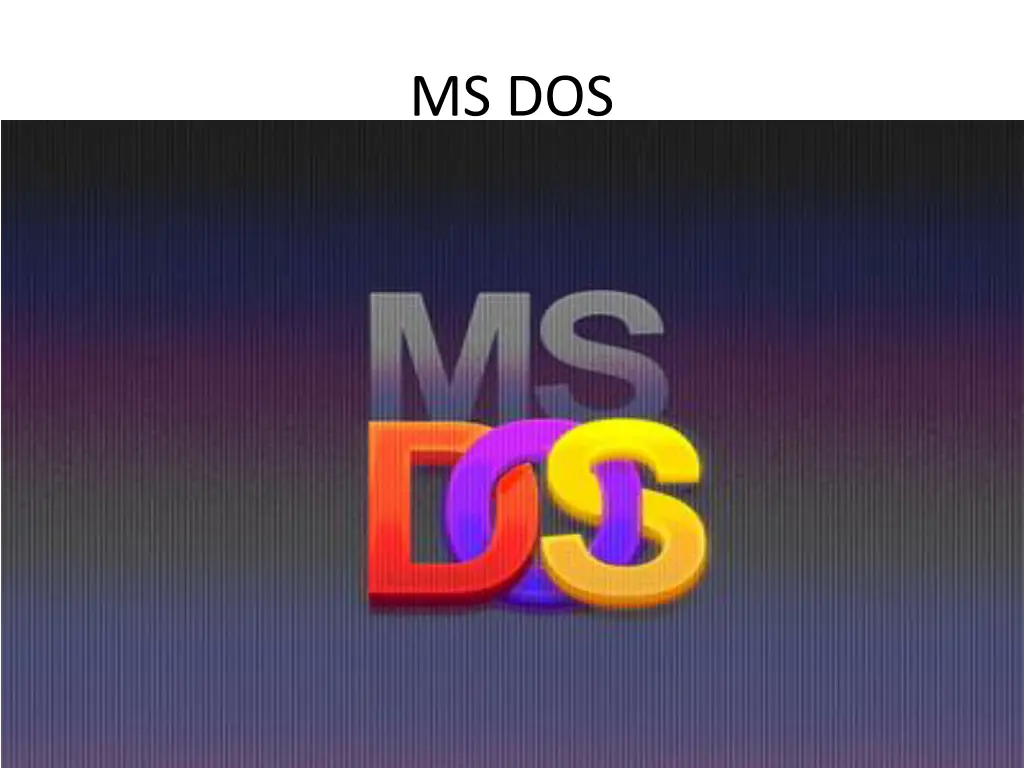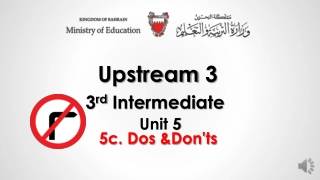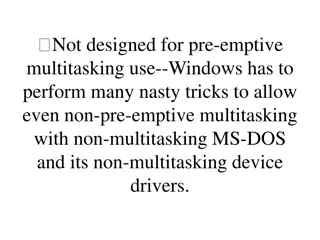
History of MS-DOS Operating System
Learn about the history of MS-DOS, the Microsoft Disk Operating System widely used in personal computers. Discover its evolution, versions, and commands, along with its relation to IBM PC-DOS and Microsoft Windows.
Download Presentation

Please find below an Image/Link to download the presentation.
The content on the website is provided AS IS for your information and personal use only. It may not be sold, licensed, or shared on other websites without obtaining consent from the author. If you encounter any issues during the download, it is possible that the publisher has removed the file from their server.
You are allowed to download the files provided on this website for personal or commercial use, subject to the condition that they are used lawfully. All files are the property of their respective owners.
The content on the website is provided AS IS for your information and personal use only. It may not be sold, licensed, or shared on other websites without obtaining consent from the author.
E N D
Presentation Transcript
What is MS-DOS (Microsoft Disk Operating System)? MS-DOS stands for Microsoft Disk Operating System and is also known as Microsoft DOS. MS-DOS was the Microsoft-marketed version of the first operating system to be widely installed on personal computers (PCs). It was essentially the same OS that Bill Gate's young company developed for IBM as Personal Computer - Disk Operating System (PC-DOS). In 1981, IBM licensed and marketed its PC-DOS rebranding of MS- DOS to run on IBM PCs. MS-DOS was released for x86 computers, went through eight major versions and was ultimately retired from all active support in 2006. Most users of either DOS system simply referred to it as Disk operating system.Like PC-DOS, MS-DOS was -- and still is -- a non-graphical, line-oriented, command-driven OS. It has a relatively simple but not overly friendly user interface. Its prompt to enter an
The default command prompt shows the disk drive currently in use. This type of computer interface, where commands are input in response to a text prompt, is called a command-line interface . In this example, drive "C:" represents the system's primary hard disk drive. When booting MS-DOS from a floppy disk, the command prompt would be A:> where "A:" represents the primary floppy disk drive. The first version of the Microsoft Windows OS was really an application that ran on top of MS-DOS. Today, Windows operating systems emulate MS-DOS to continue to support DOS -- or a DOS-like user interface -- for special purposes. In the 1970s before the PC was invented, IBM had a different and unrelated DOS that ran on smaller business computers. It was replaced by IBM's VSE (Virtual Storage Extended) OS.
MS-DOS version history The history of MS-DOS is inextricably linked to the development of the personal computer, the IBM branded PC-DOS version and Microsoft Windows -- which originally was implemented as a graphical program running on MS-DOS. Here is a time line of MS-DOS milestones: 1981. Microsoft buys the precursor OS to MS-DOS called 86-DOS -- also known as the Quick and Dirty Operating System -- from Seattle Computer Products and renames it MS-DOS. 1982. MS-DOS version 1.24 is supplied to IBM and released as PC-DOS 1.1. 1983. MS-DOS 2.0 is released to accompany IBM's hard-drive-equipped computer, the IBM PC XT. This MS-DOS version added support for hard drives and subdirectories. 1984. MS-DOS 3.1 is released in Europe. It is the first MS-DOS version to include local area network support. 1985. Microsoft releases MS-DOS 3.2 to IBM. 1987. MS-DOS 3.3 ships with support for 3.5-inch floppy disks (1.44 Mb). 1988. MS-DOS 4.01 ships with support for larger hard drives up to 2 Gb. 1991. MS-DOS 5.0 ships. It is a major update that replaced GW-BASIC with Microsoft QBasic. It added the EDIT full-screen text editor, an improved memory manager and support for dual- density 3.5-inch disks (2.88 Mb). This was the last version of MS-DOS developed with IBM's PC- DOS. 1992. MS-DOS 6.0 ships with disk management tools and backup and file transfer tools. 1994. MS-DOS 6.22 is the last Microsoft release of standalone MS-DOS. 1995. The CLI implemented in Windows 95 represents itself as MS-DOS 7.0. 2000. MS-DOS 8.0 is included in Windows ME. It is the last version of MS-DOS.
MS-DOS commands Entered at the command prompt, MS-DOS commands are default functions included in the OS. Depending on which version is being used, there are about 100 MS-DOS commands. Other types of executable programs, while not a part of the OS, are entered at the command line in the same way as DOS commands. Executable programs include these two: Batch files are text files containing sequences of MS-DOS commands that use programming constructs such as loop and GOTO statements. Batch file can include MS-DOS commands as well as application programs. Application programs are binary executable files that have been compiled from source code. Working at the command line was an important skill for early PC users. Most of those users worked primarily with applications such as spreadsheets, word Processor and file managers. Common MS-DOS commands include the following: Command Example Notes CD C:\> CD \user\programs C:\user\programs> Changes the current directory to the specified path. When entered with no path, it displays the current working directory's name. If the path is included in the command prompt, the prompt will change as in the example (see also PROMPT, below). CHKDSK C:\> CHKDSK a: Checks the specified disk -- in this case, the floppy disk in the A: drive -- and returns a status report showing the disk size, number of files and directories in use and number of bytes used. COPY C:\> COPY autoexec.bat autoexec.BAK Copies specified file or files. Can be used to copy files to duplicates with different file names or to copy files into a different directory without changing names.
How to use MS-DOS There are currently at least four ways to use MS-DOS: 1.Legacy systems, specifically older IBM PC-compatible computers, are still in use. Many are still running some version of MS-DOS. 2.Compatible OSes have been published over the years, including at least two open Source implementations of MS-DOS that are still actively maintained. Other MS-DOS-compatible OSes are commercially available for use in embedded systems. 3.MS-DOS emulators are software constructs that virtually reconstruct the experience of working with MS-DOS. Microsoft released the source code and binaries for two versions of MS- DOS to be used for education and experimentation.




![GET [✔PDF✔] DOWNLOAD✔ The Ultimate Burger: Plus DIY Condiments, Sides, and](/thumb/68033/get-pdf-download-the-ultimate-burger-plus-diy-condiments-sides-and.jpg)

















